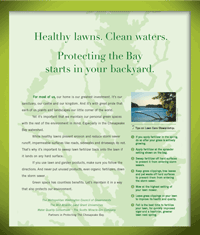“Healthy Lawns, Clean Water” campaign unites business, government and academic organizations to raise awareness of environmentally friendly lawn care techniques

Protecting the Chesapeake Bay starts in the backyard of homeowners throughout the region. This key message is being communicated through a new educational campaign unveiled today that encourages homeowners to do their part in protecting the Chesapeake Bay watershed. Titled “Healthy Lawns, Clean Water,” the campaign will include advertisements in major media outlets in the Bay area as well as public service announcements, public speaking opportunities and other homeowner outreach.
The effort, which is supported by The Scotts Miracle-Gro Company, the Metropolitan Washington Council of Governments and the Mid-Atlantic Land Grant Universities Water Quality Consortium, promotes seven simple lawn care techniques that can help protect the Bay and improve the environment.
“If every homeowner followed these tips, and took other simple actions around their home, it would result in cleaner local streams and a healthier Chesapeake Bay,” said Martin Nohe, chairman of the Chesapeake Bay and Water Resources Policy Committee of the Metropolitan Washington Council of Governments. “We hope our effort can positively impact consumer behavior over the long-run and provide a national model demonstrating the environmental impact that public and private organizations can have when working toward a common goal.” Mr. Nohe also is a member of the Prince William County (VA) Board of County Supervisors.
Academic research has repeatedly confirmed that healthy and properly maintained lawns and landscapes can have a positive impact on the environment by trapping particulate matter, absorbing up to an inch of rainfall, and preventing soil erosion. However, off-target application of lawn and garden products – for example, lawn fertilizer or pest control products spilled on hard surfaces like driveways and sidewalks – can have a detrimental impact on the environment and water quality.
The “Healthy Lawns, Clean Water” campaign is designed to remind homeowners of the following steps they can take to protect the environment while nurturing their lawn or garden:
- If applying fertilizer in the spring, do so after the grass is actively growing.
- Apply fertilizer at the spreader setting shown on the bag.
Sweep fertilizer off hard surfaces to prevent it from entering storm sewers.
- Keep grass clippings, tree leaves and pet waste off hard surfaces to prevent them from entering the storm sewer.
- Mow at the highest lawn mower setting.
- Leave grass clippings on the lawn to improve its health and quality.
- Fall is the best time to fertilize your lawn, for quickly improved vigor and a healthier, greener lawn next spring.
“Whether we work in the private or the public sector, all of us should share the common goal of leaving our environment in better condition for our children than what we inherited from our parents,” said Rich Martinez, chief environmental officer of ScottsMiracle-Gro. “The goal of our combined outreach effort is to help homeowners in the Chesapeake Bay watershed, whether they use our products or not, to better understand how they can protect the Bay while beautifying their homes with healthy lawns and gardens.”
Martinez said research conducted recently by ScottsMiracle-Gro showed that most homeowners want to be more proactive in protecting the environment but did not believe their individual contributions could make a difference. However, the research also showed homeowners often did not fully understand important issues. For example, most homeowners incorrectly believed that storm water was treated before entering lakes, rivers, creeks or even estuaries like Chesapeake Bay.
“Educating homeowners about proper lawn and landscape methods is very important,” said Carin Bisland, associate director of the Chesapeake Bay Program (CPB). “This campaign will help people realize the positive environmental impact they can have in their everyday lives and activities. Small steps, like those outlined in this campaign, can make a difference when multiplied by the hundreds of thousands of homeowners who live in the region.”
The vice-chair of the Chesapeake Bay Policy Committee, Judith Davis, Mayor of Greenbelt, MD, praised the new partnership. “One in four people living in the Bay watershed call the Washington region home, and soon that will increase to one in three people. Consequently, even a small action – like making sure fertilizer stays on the lawn – can really benefit local water quality and the Bay,” she said.
Tom Simpson, a coordinator the Mid-Atlantic Land Grant Universities Water Quality Consortium, said he hopes the diversity of the sponsorship of the campaign will create credibility with homeowners.
“Most people take great pride in their lawn and garden, especially in the spring,” Simpson said. “We want homeowners to know that it’s ok to create beautiful landscapes. Take a few minutes to follow some simple steps to be better environmental stewards. The most basic step homeowners can take is making sure fertilizer stays on the lawn – not on the driveway. By keeping lawn products off of hard surfaces, we greatly minimize the potential for nutrient flow into storm sewers, which means a cleaner Chesapeake Bay for all of us.”